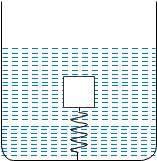
A block is submerged in a vessel filled with water by a spring attached to the bottom of the vessel. In equilibrium spring is compressed. The vessel now moves downwards with an acceleration a $(<\mathrm{g}) .$ The spring length

(a) will become zero
(b) may increase, decrease or remain constant
(c) will decrease
(d) will increase
Answer
217.8k+ views
Hint: We know that a body at rest in a fluid is acted upon by a force pushing upward called the buoyant force, which is equal to the weight of the fluid that the body displaces. If the body is completely submerged, the volume of fluid displaced is equal to the volume of the body. If the body is only partially submerged, the volume of the fluid displaced is equal to the volume of the part of the body that is submerged. Based on this concept we have to answer this question.
Complete step by step answer
We know that when the vessel moves downwards, with acceleration, the block experiences a net pseudo force upwards. Hence, the apparent weight of the block decreases and the block moves upwards. Therefore, the length of the spring increases. Additional force on the block in upward direction-pseudo force on the block-decrease in buoyancy force.
at equilibrium
$k x+m g=F_{b}$
$k x_{1}=F_{b}-m g$
$x_{1}=\left(F_{b}-mg\right) / K$
When the vessel moves down,
$k x_{2}+mg=F_{b}+ma$
$k x_{2}=\left(F_{b}+ma\right)-mg$
$x_{2}=\dfrac{\left(F_{b}+ma\right)-mg}{K}$
${{x}_{2}}>{{x}_{1}}$
Hence, we can see that the length of spring increases.
Therefore, the correct answer is Option D.
Note: To answer such a question, it should be known to us that Archimedes' principle is very useful for calculating the volume of an object that does not have a regular shape. The oddly shaped object can be submerged, and the volume of the fluid displaced is equal to the volume of the object. It can also be used in calculating the density or specific gravity of an object.
Let us explain with the help of an example, for an object denser than water, the object can be weighed in air and then weighed when submerged in water. When the object is submerged, it weighs less because of the buoyant force pushing upward. The object's specific gravity is then the object's weight in air divided by how much weight the object loses when placed in water. But most importantly, the principle describes the behaviour of anybody in any fluid, whether it is a ship in water or a balloon in air.
Complete step by step answer
We know that when the vessel moves downwards, with acceleration, the block experiences a net pseudo force upwards. Hence, the apparent weight of the block decreases and the block moves upwards. Therefore, the length of the spring increases. Additional force on the block in upward direction-pseudo force on the block-decrease in buoyancy force.
at equilibrium
$k x+m g=F_{b}$
$k x_{1}=F_{b}-m g$
$x_{1}=\left(F_{b}-mg\right) / K$
When the vessel moves down,
$k x_{2}+mg=F_{b}+ma$
$k x_{2}=\left(F_{b}+ma\right)-mg$
$x_{2}=\dfrac{\left(F_{b}+ma\right)-mg}{K}$
${{x}_{2}}>{{x}_{1}}$
Hence, we can see that the length of spring increases.
Therefore, the correct answer is Option D.
Note: To answer such a question, it should be known to us that Archimedes' principle is very useful for calculating the volume of an object that does not have a regular shape. The oddly shaped object can be submerged, and the volume of the fluid displaced is equal to the volume of the object. It can also be used in calculating the density or specific gravity of an object.
Let us explain with the help of an example, for an object denser than water, the object can be weighed in air and then weighed when submerged in water. When the object is submerged, it weighs less because of the buoyant force pushing upward. The object's specific gravity is then the object's weight in air divided by how much weight the object loses when placed in water. But most importantly, the principle describes the behaviour of anybody in any fluid, whether it is a ship in water or a balloon in air.
Recently Updated Pages
Elastic Collision in Two Dimensions Explained Simply

Elastic Collisions in One Dimension Explained

Electric Field Due to a Uniformly Charged Ring Explained

Electric Field of Infinite Line Charge and Cylinders Explained

Electric Flux and Area Vector Explained Simply

Electric Field of a Charged Spherical Shell Explained

Trending doubts
JEE Main 2026: Application Form Open, Exam Dates, Syllabus, Eligibility & Question Papers

Derivation of Equation of Trajectory Explained for Students

Hybridisation in Chemistry – Concept, Types & Applications

Understanding the Angle of Deviation in a Prism

Understanding Collisions: Types and Examples for Students

How to Convert a Galvanometer into an Ammeter or Voltmeter

Other Pages
JEE Advanced Marks vs Ranks 2025: Understanding Category-wise Qualifying Marks and Previous Year Cut-offs

Units And Measurements Class 11 Physics Chapter 1 CBSE Notes - 2025-26

NCERT Solutions For Class 11 Physics Chapter 8 Mechanical Properties Of Solids

Motion in a Straight Line Class 11 Physics Chapter 2 CBSE Notes - 2025-26

NCERT Solutions for Class 11 Physics Chapter 7 Gravitation 2025-26

Understanding Atomic Structure for Beginners




